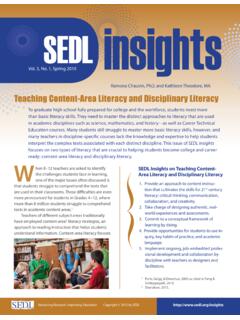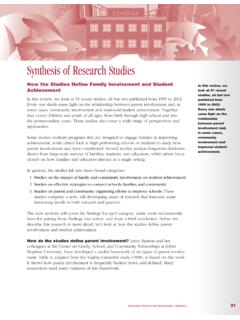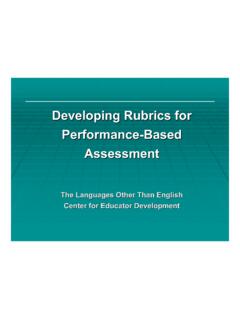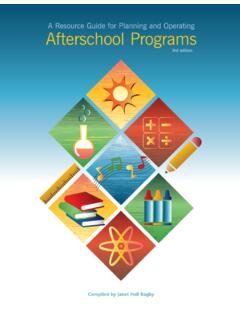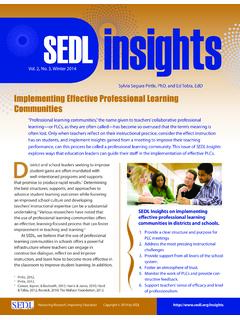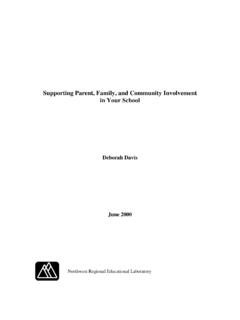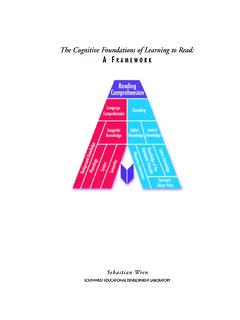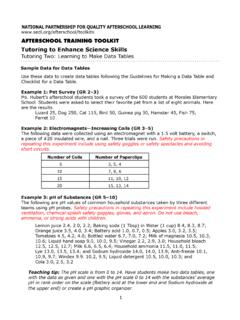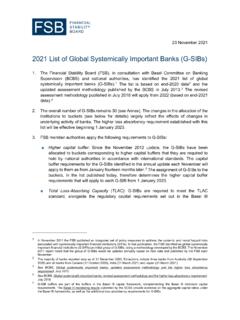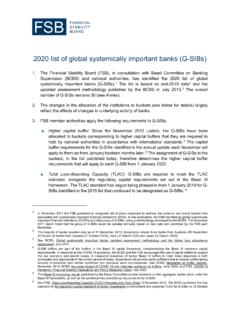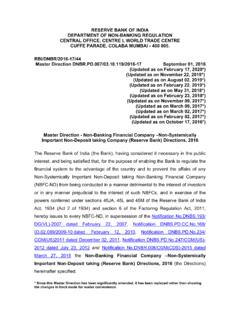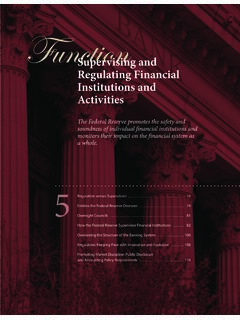Transcription of The Professional Teaching and Learning Cycle: Introduction
1 The Professional Teaching and Learning cycle : Introduction2nd EditionThe Professional Teaching and Learning cycle (PTLC) is a Professional development process in which teachers collaboratively plan and implement lessons aligned to their state standards. This process is an important part of the Working systemically approach, designed by the Southwest Educational Development Laboratory (SEDL) to improve a school system s capacity to increase student ii -SEDL4700 Mueller Blvd. Austin, TX 78723 Phone 800-476-6861 FAX 512-476-2286 Web Copyright 2005 (2nd edition, 2008) by Southwest Educational Development Laboratory. This publication was produced in whole or in part with funds for the Institute of Education Sciences, Department of Education, under contract number ED-01-C0-0009. The content herein does not necessarily reflect the views of the Department of Education or any other agency of the government, nor does it reflect the views of any other Is the Professional Teaching and Learning cycle ?
2 1 The Six Steps of the Professional Teaching and Learning cycle ..3 How to Begin .. 6 Leadership and Support .. 7 Culture .. 8 Summing Up.. 9 References .. 10 SEDL1 The Professional Teaching and Learning cycle (PTLC) is a Professional development process in which teachers collaboratively plan and implement lessons aligned to their state standards. This process is an important part of the Working systemically approach, designed by SEDL to improve a school system s capacity to increase student achievement. Working in partnership with the Charles A. Dana Center at the University of Texas at Austin, SEDL developed this job-embedded process that reflects the research on Professional development and school improvement. PTLC is a critical component of the Working systemically approach that directly impacts classroom instruction and student Learning . It is a vehicle for teacher collaboration and sharing, and the process improves alignment of curriculum, instruction, and assessment to the state is an ongoing, cyclic process that is designed to improve the quality of Professional development (ongoing, job-embedded, results-driven); Professional collaboration among staff; use of data to inform instructional and programmatic decisions; alignment of curriculum, instruction, and assessment to the state standards; quality and coherence of instruction across classrooms; monitoring of student Learning ; and leadership-support systems for continuous school , interventions aimed at improving student achievement target only individual components of school improvement and Professional development.
3 A school improvement initiative might focus on improving alignment of the curriculum or on the collection and use of data. These interventions tend to result in marginal gains in student achievement, but little evidence suggests that those gains persist beyond the time of the intervention. PTLC, on the other hand, is designed to work systemically . It addresses teacher quality and school improvement both collectively and holistically, thus increasing the likelihood that improvements will be sustained over is not a simple process, nor is it a quick fix for school improvement. A substantial amount of commitment and work is necessary to develop the process into a meaningful instructional improvement strategy. Once established, it becomes a standard way for a district and schools to operate, providing job-embedded, ongoing Professional development in a collaborative, trusting environment. Most schools and districts will need support from an external facilitator or technical assistance provider for the first few years to help develop PTLC and incorporate it into their educational system (Rust, 2001).
4 Over time, however, the external facilitator can gradually shift responsibility for support to internal leaders, thus decreasing the school s dependence on external consultants for ongoing, sustainable Is the Professional Teaching and Learning cycle ? Professional Teaching and Learning Cycle2 SEDLI ntroductionOne of the key strengths of PTLC is its design as a job-embedded Professional Learning process that is ongoing and results driven. According to multiple correlation studies on teacher quality (Darling-Hammond, 2000; Darling-Hammond, Hightower, Husbands, LaFors, Young, & Christopher, 2003), higher levels of student achievement are associated with educators who participate in sustained Professional development grounded in content-specific pedagogy. Continuous Professional Learning that improves teacher outcomes, in turn, impacts student outcomes. Studies indicate that when teachers improve their instructional practice, student achievement also improves (Fishman, Marx, Best, & Tal, 2003; Guskey, 2000; Kamil, 2003).
5 The design of Professional development, therefore, is critical to school improvement. A longitudinal study conducted by the National Partnership for Excellence and Accountability in Teaching (1999) identified several characteristics that proved most effective in positively influencing teacher practice. Three of those identified characteristics that are strongly emphasized in PTLC are collective participation, active Learning with opportunities for direct application, and coherence with school goals and state evidence (Fernandez, 2003; Joyce & Showers, 2002; Poglinco, Bach, Hovde, Rosenblum, Saunders, & Supovitz, 2003; Reeves, 2004; Seagall, 2004; Sparks & Hirsch, 2000; Wheelan, 2005) also suggests that Professional development should provide opportunities for teachers to build their content and pedagogical knowledge and to examine practices; be research based and engage adults in the Learning approaches they will use with their students; provide opportunities for teachers to collaborate with colleagues and other experts to improve their practices.
6 And include a design based on student Learning data that will be evaluated and improved support from school leaders is required for implementing, supporting, and sustaining high-quality Professional development (Cotton, 2003; NAESP, 2001). In addition, strong leadership is needed for fostering a culture of collaboration and problem solving (Marzano, Waters, & McNulty, 2005). Good leaders set clear academic goals and monitor progress toward those goals (Cotton, 2003; Joyce & Showers, 2002; Marzano et al., 2005; NAESP, 2001; Reeves, 2004); link those goals to Professional development (Joyce & Showers, 2002; Reeves, 2004); and monitor implementation of innovations and changes in the instructional program (Cotton, 2003; Marzano et al., 2005; NAESP, 2001).Additionally, guidance and support from district and school leaders is critical for institutionalizing an effort of this scale and achieving the potential results such a process offers.
7 This publication, The Professional Teaching and Learning cycle : Introduction , provides a detailed overview of the process and outlines the objectives for each of the six steps and the overall cycle . It also addresses the importance of leadership roles and the culture and conditions necessary to support PTLC. The information presented herein provides the grounding needed in order to understand and explain PTLC to teachers and leaders as they work through this Teaching and Learning Cycle3 SEDLI ntroductionThe Six STePS of The Professional Teaching and Learning cyclePTLC comprises six steps study, select, plan, implement, analyze, and adjust. On the following pages is a description of and the goals for each step. Prior to beginning the cycle , teachers will have analyzed student achievement data to identify a specific standard or standards on which many students are not Teaching and Learning Cycle4 SEDLI ntroductionStep 1: StudyTeachers work in collaborative planning teams (grade-level, vertical, or departmental) to examine critically and discuss the Learning expectations from the selected state standards.
8 Teachers working collaboratively develop a common understanding of the concepts and skills students need to know and be able to do to meet the expectations in the standards, how the standards for a grade or course are assessed on state and local tests, and how the standards fit within a scope and sequence of the district 2: Select Collaborative planning teams research and select instructional strategies and resources for enhancing Learning as described in the standards. Teachers working collaboratively identify effective research-based strategies and appropriate resources that will be used to support Learning in the selected state standards and agree on appropriate assessment techniques that will be used to provide evidence of student 3: Plan Planning teams, working together, formally develop a common lesson incorporating the selected strategies and agree on the type of student work each teacher will use later (in Step V: Analyze) as evidence of student Learning .
9 Teachers working collaboratively develop a common formal plan outlining the lesson objectives (relevant to the standards), the materials to be used, the procedures, the time frame for the lesson, and the activities in which students will be engaged and decide what evidence of student Learning will be collected during the 4: Implement Teachers carry out the planned lesson, make note of implementation successes and challenges, and gather the agreed-upon evidence of student Learning . Teachers working collaboratively deliver the lesson as planned within the specified time period; record results, especially noting where students struggled and/or where instruction did not achieve expected outcomes; and collect the agreed-upon evidence of student Learning to take back to the collaborative planning Teaching and Learning Cycle5 SEDLI ntroductionStep 5: Analyze Teachers gather again in collaborative teams to examine student work and discuss student understanding of the standards.
10 Teachers working collaboratively revisit and familiarize themselves with the standards before analyzing student work; analyze a sampling of student work for evidence of student Learning ; discuss whether students have met the expectations outlined in the standards and make inferences about the strengths, weaknesses, and implications of instruction; and identify what students know and what skills or knowledge needs to be strengthened in future 6: Adjust Collaborative teams reflect on the implications of the analysis of student work. Teachers discuss alternative instructional strategies or modifications to the original instructional strategy that may be better suited to promoting student Learning . Teachers working collaboratively reflect on their common or disparate Teaching experiences; consider and identify alternative instructional strategies for future instruction; refine and improve the lesson; and determine when the instructional modifications will take place, what can be built into subsequent lessons, and what needs an additional targeted lesson.

